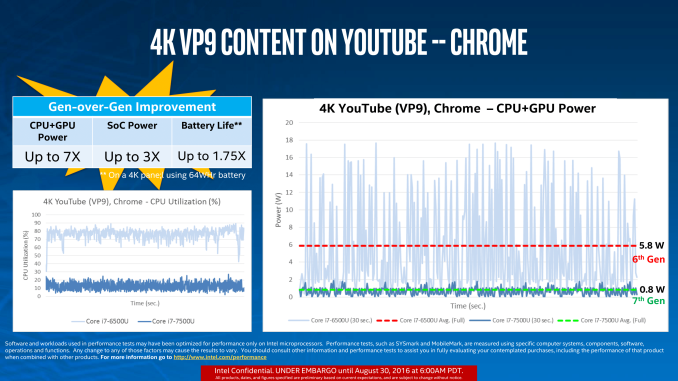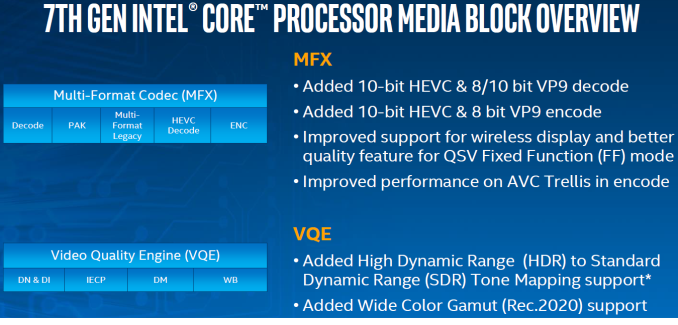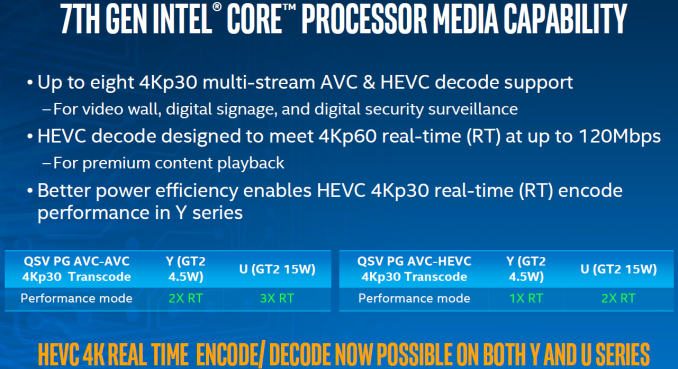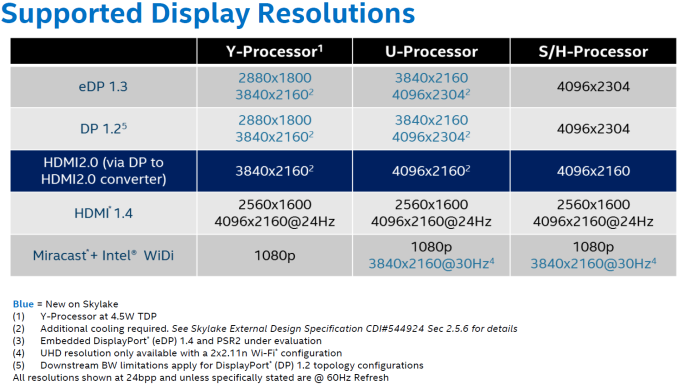Intel Launches 7th Generation Kaby Lake: 15W/28W with Iris, 35-91W Desktop and Mobile Xeon
by Ian Cutress on January 3, 2017 12:01 PM ESTThe Kaby Lake-U/Y GPU - Media Capabilities
Written by Ganesh
While from a feature standpoint Kaby Lake is not a massive shift from Skylake, when it comes to GPU matters it none the less brings across some improvements that are directly visible to the end-user. As with the CPU cores, Intel’s 14nm+ process will allow for higher GPU frequencies and overall better GPU performance, but arguably the more impressive change with Kaby Lake is the updated media capabilities. To be clear, Kaby Lake is still an Intel Gen9 GPU – the core GPU architecture has not changed – but Intel has revised the video processing blocks to add further functionality and improve their performance for Kaby Lake.
The media capabilities of the Skylake GPU were analyzed in great detail in our 2015 IDF coverage. The updates to Kaby Lake-U/Y should be analyzed while keeping those features in mind. The major feature change in the Kaby Lake-U/Y media engine is the availability of full hardware acceleration for encode and decode of 4K HEVC Main10 profile videos. This is in contrast to Skylake, which can support HEVC Main10 decode up to 4Kp30, but does so using a “hybrid” process that spreads out the workload over the CPU, the GPU’s media processors, and the GPU’s shader cores. As a result, not only can Kaby Lake process more HEVC profiles in fixed function hardware than before, but it can do so at a fraction of the power and with much better throughput.
Also along these lines, Kaby Lake has implemented full fixed function 8-bit encode and 8/10-bit decode support for Google’s VP9 codec. Skylake offered hybrid decode support for the codec, which is useful from a feature standpoint, but is a bit more problematic in real-world use since it’s not as power-efficient to use VP9 a codec implemented in fixed function hardware. Google has proven eager to serve up VP9 to its YouTube users, so they can now much more efficiently decode the codec. Meanwhile, on the encode side, brand-new to Kaby Lake is VP9 encoding support, to go with the aforementioned HEVC encode support.
An overview of the GPU engine in Kaby Lake-U/Y is presented in the slide below.
The new circuitry for hardware accelerating HEVC Main10 and VP9 are part of the MFX block. The MFX block can now handle 8b/10b HEVC and VP9 decode and 10b HEVC / 8b VP9 encode. The QuickSync block also gets a few updates to improve quality further, and AVC encode performance also receives a boost.
The Video Quality Engine also receives some tweaks for HDR and Wide Color Gamut (Rec.2020) support. Skylake's VQE brought in RAW image processing support with a 16-bit image pipeline for selected filters. While Intel has not discussed the exact updates that enable Rec.2020 support, we suspect that more components in the VQE can now handle higher bit-widths. Intel pointed out that the HDR capabilities involve usage of both the VQE and the EUs in the GPU. So, there is still scope for further hardware acceleration and lower power consumption in this particular use-case.
Intel claims that Kaby Lake-U/Y can handle up to eight 4Kp30 AVC and HEVC decodes simultaneously. HEVC decode support is rated at 4Kp60 up to 120 Mbps (especially helpful for premium content playback and Ultra HD Blu-ray). With Kaby Lake-U/Y's process improvements, even the 4.5W TDP Y-series processors can handle real-time HEVC 4Kp30 encode.
On the subject of premium content, in their presentation Intel rather explicitly mentioned that the improved decode capabilities were, in part, for “premium content playback.” When we pushed Intel a bit on the matter – and specifically on 4K Netflix support – they didn’t have much to say beyond the fact that to play 4K Netflix, you need certification. Based on what was said and what was not said (and what we know about the certification process) our educated guess is that the updates in Kaby Lake-U/Y include some new DRM requirements for 4K content, and 4K Netflix should hopefully be good to go with the new platform. However on that note, because of those DRM requirements and that this is being pitched as a new feature for Kaby Lake, we suspect that when 4K Netflix streaming does come to the PC platform, Skylake owners are going to be out of luck.
It must be kept in mind that all the encode / decode aspects discussed above are for 4:2:0 streams. This is definitely acceptable for consumer applications, as even Blu-ray video streams (that have plenty of bandwidth at their disposal) are encoded in 4:2:0. However, if Intel wants to use the new media engine in professional broadcast and datacenter applications, 4:2:2, and, to a much lesser extent, even 4:4:4 support might become necessary. For the purpose of the Kaby Lake-U/Y consumer platforms being introduced today, this is not an issue at all.
Moving on, like the GPU core itself, Kaby Lake-U/Y's display pipeline is the same as that of Skylake. This means the iGPU can support up to three simultaneous displays.
One of the disappointing aspects from Skylake that has still not been addressed in Kaby Lake-U/Y is the absence of a native HDMI 2.0 port with HDCP 2.2 support. Intel has been advocating the addition of an LSPCon (Level Shifter - Protocol Converter) in the DP 1.2 path. This approach has been used in multiple motherboards and even SFF PCs like the Intel Skull Canyon NUC (NUC6i7KYK) and the ASRock Beebox-S series. Hopefully, future iterations of Kaby Lake (such as the desktop and high-performance mobile parts coming in January) address this issue to simplify BOM cost for system vendors.
In summary, Kaby Lake-U/Y resolves one of the major complaints we had about Skylake's media engine: the absence of hardware-accelerated 4Kp60 HEVC Main10 decode. There are a few other improvements under the hood that enable a more satisfying multimedia experience for consumers. The software and content-delivery ecosystems have plenty of catching up to do when it comes to taking full advantage of Kaby Lake-U/Y's media capabilities.
















43 Comments
View All Comments
Lolimaster - Tuesday, January 3, 2017 - link
It's the same damn skylake with a more "mature" process. Before you could call that "release new models" like FX8350 and later the 8370.Calling it a new generation is laughable. Haswell refresh got the 4790K after the initial 4770K,
marc1000 - Friday, January 6, 2017 - link
even as some specific benchmarks show 20% to 30% improvements over 2600k, when I look at gaming I loose all interest to upgrade. my computer is either idle (browsing or light use) or is gaming. to 90% of users with a "generic" profile, there is hardly any reason to leave a Sandy-bridge computer.of course, ultra-thin notebooks and other low-power equipments can put the newer cpus to good use. but wherever a 2600k can already fit, there is no reason to change it. I am keeping my 2500k for yet another cycle here... (maybe this is the result of a lack of competition for some years???)
@Ian, if possible please include a comparison of a 2500k or 2600k Sandy at 4Ghz vs the newer 7600 or 7700 processors. if this is possible of course.
limitedaccess - Tuesday, January 3, 2017 - link
So $305 is the official MSRP? This makes it cheapest mainstream i7 k series release yet?According to Anandtech's review even the first 2600k had a higher $317 MSRP, 3770k was the previous lowest at $313.
Ken_g6 - Tuesday, January 3, 2017 - link
Ars Technica says it's $350, not $305. Typo?http://arstechnica.com/gadgets/2017/01/intel-core-...
limitedaccess - Tuesday, January 3, 2017 - link
Looking at some other reviews, Tom's, Techreport and PCPer say $339.cfenton - Tuesday, January 3, 2017 - link
On the final page it says, "At the end of the day, the Core i7-7700K... has a tray price of $305. This means it will probably reach shelves around $330-$350, and we haven’t heard about a new stock cooler so it will probably come without one."So $305 is the tray price and retail will be $330-$350.
Casper42 - Tuesday, January 3, 2017 - link
> I highly suspect that the Xeon CPUs will be announced later in Q1, given that the target market for these is a little different to standard desktop processors.Late March
chucky2 - Tuesday, January 3, 2017 - link
I hope in the chipset review piece you're doing later, you address what future CPU's will be supported under series 200 socket 1151 motherboards. For example, is Intel committing to Coffee Lake support on these boards? Cannonlake? I.e. How much longevity are we going to get with these boards? Same same on the Xeon boards front for it's chipset.TEAMSWITCHER - Tuesday, January 3, 2017 - link
I'm thinking the longevity will be very short. Z270 is to Z170 ... just as ... Z97 was to Z87. Intel's 10 nm processors will probably introduce a new socket.chucky2 - Wednesday, January 4, 2017 - link
If Z270 really is like Z97, that will be a complete joke.I'm starting to wonder if the physical limits have basically been reached, and we're slowly (whether by Corp design or physics, or, some of both), just hitting the wall and this is essentially it.